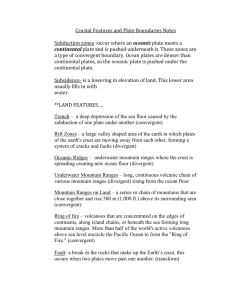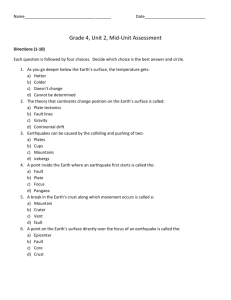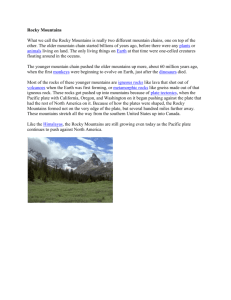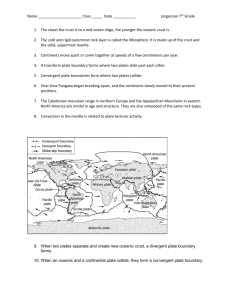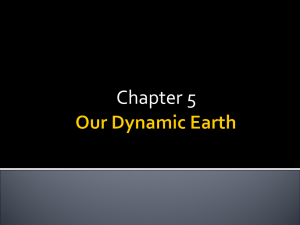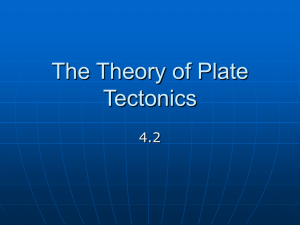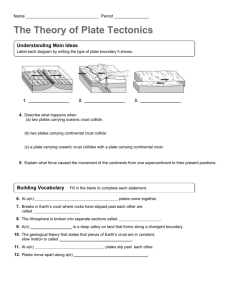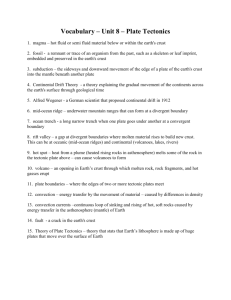GEOL-1403-McMahon
advertisement
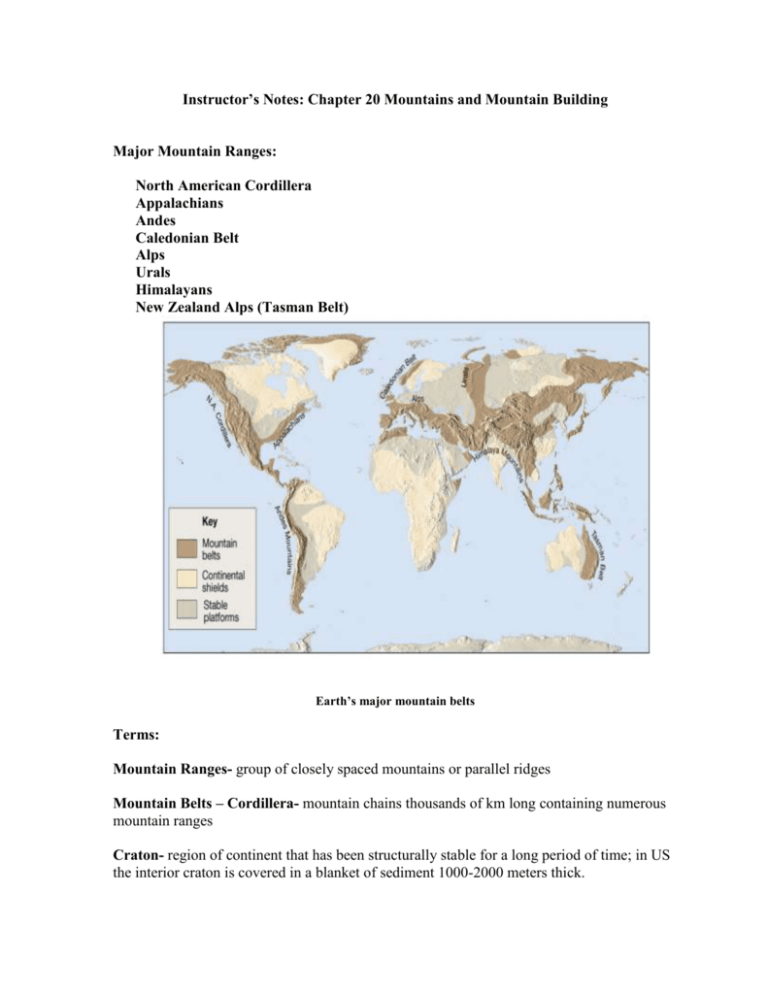
Instructor’s Notes: Chapter 20 Mountains and Mountain Building Major Mountain Ranges: North American Cordillera Appalachians Andes Caledonian Belt Alps Urals Himalayans New Zealand Alps (Tasman Belt) Earth’s major mountain belts Terms: Mountain Ranges- group of closely spaced mountains or parallel ridges Mountain Belts – Cordillera- mountain chains thousands of km long containing numerous mountain ranges Craton- region of continent that has been structurally stable for a long period of time; in US the interior craton is covered in a blanket of sediment 1000-2000 meters thick. Precambrian Shield- eroded remnant of Precambrian mountain range. Characteristic Features of Mountain Belts Longer than wider Higher mountains tend to be geologically younger Mountains are associated with convergent plate boundaries Oceanic-oceanic Oceanic- continental Continental- continental Folding Faulting in Mountain Ranges: Tighter folds indicate greater stress, recumbent of overturned folds= more intense deformation reverse faults are also common Fold and fault belts including Trust faults – Detachment faults Fold and Trust Belts = crustal shortening and crustal thickening Example: The Alps are made of rock units that once covered an ocean floor of 500 km compressed into current width of 200 km. Sedimentary Rocks: Sedimentary rocks on the craton are 1000-2000 meters thick little deformation may show gentle warping into basin and domes, and tend to be continental in origin. Example: Colorado Plateau, Central United States and Canada. In contrast, sedimentary rocks in mountain belts are deformed and thick and most likely of marine origin mixed with volcanic rocks. Why? Crustal Thickness: Continental crust is thicker and less dense than oceanic crust. Crust is thicker beneath mountain belts (an exception is the Basin and Range Providence). Crust is thicker under younger mountain belt than older ones. Remember : Seismic velocities indicate an average continental crustal density equivalent to granite where the average oceanic crust density is equivalent to basalt. Thematic cross-section across the United States- note the crust is thicker beneath the younger (Cenozoic) North American Cordillera and thinner under the older (Paleozoic Mesozoic) Appalachian Mountains. The Appalachians were once as tall as the North American Cordillera but have been eroding for a much longer period of time ( over 200 my). Mountain Building: Young Mountain Ranges (past 100 million yrs) American Cordillera, Alpine –Himalayan (45 mya) Japan, Philippines, Sumatra- island arcs Older Mountain Ranges Appalachians Urals Caledonians Three Stages of Mountain Building: 1) Accumulation Stage 2) Orogenic Stage 3) Uplift and Block-Faulting Stage Stage 1: Accumulation Stage: Deposition of sedimentary and volcanic rocks – sedimentary rock generally in a marine environment Passive Continental Margin – modern examples: North American Atlantic Coastmostly sedimentary and metamorphic rock - little or no volcanic activity Active Continental Margin- modern examples: North America Pacific Coast-andesitic volcanoes, sedimentary rocks= greywacke, deposited on the seaward side of the convergent plates Stage 2: Orogenic Stage Orogeny- a period of intense deformation of rocks in a region usually associated with metamorphism and igneous activities. Associated with Convergent Plate Boundaries Oceanic –Continent Convergent Plate Boundaries Oceanic –Oceanic Convergent Plate Boundaries Continental-Continental Convergent Plate Boundaries Oceanic Continental Convergent Lithospheric Plate Boundary: Also called Andean -Type Mountain Building Formation of accretion wedges- marine sediment that is folded and faulted as they are pushed off the subduction oceanic plate Sedimentary rock caught and pushed down in the subduction zone will be subjected to intense shear stress and metamorphosed Folding and trust belt on the back arc of the side of the mountain belt- trusting away from the magmatic arc towards the craton. Mountain building is the result of: Crustal shortening Gravity collapse and spreading Expanding magmatic arc Gravitational Collapse and Spreading Gravity Collapse and Spreading The rate of uplift of rock is so great during orogenies (3 km above sea level) that the underlying rock cannot support the overburden and gravitational collapse occurs, resulting in increased pressure for metamorphism. Deep rocks behave plastically and flow, shallower rocks fracture- rock is pushed outward and help to form fold and thrust belts. Oceanic-Continental Convergence - Accretion of new continent when an island arc collides with a continent and a new subduction zone is created on the seaward side of the island arc. Accretion of accretionary wedge material Examples: Mesozoic – Sierra Nevada Complex, California. – Western North America Accreted Terrane Oceanic-Continental Convergence (figure 19.32) Oceanic-Oceanic Lithospheric Plate Convergence Also called Aleutian-Type Mountain Building shrinking ocean basins (Pacific) partial melting of mantle- volcanic emplacement sediment deposited on the shore faces and in trench Formation of a volcanic island arc Oceanic-Oceanic Convergence (figure 19.28) Continental-Continental Convergence Also called Himalayan-Type Mountain Building Ural Mountains -Collision of Asia and Africa-Paleozoic Alps – African and European Plate -Triassic Himalayas – Miocene - India with Asia plates Appalachian Mountains – more complex Continental-Continental Convergence – the formation of the Himalayan Mountains (from Lutgens and Tarbuck, 2006) Continental-Continental Convergence (figure 19.33) Stage 3: Uplift and Block Faulting: Late stage uplift after convergence stops and compressional forces relax. The mountain range moves into a period of uplift and erosion. After orogeny stage structural adjustments are considered isosatic adjustments of thickened crust The present Rocky Mountains position is the result of Cenozoic period up-warping after earlier period of folding and intense erosion. The region has risen 5000-7000 feet in the past 15-20 million years. Normal Faulting –is characteristic of this stage- Fault Block Mountains- product of extensional forces Examples: Sierra Nevada and the Tetons are tilted fault Block Mountains Isostasy (figure 20.14) Less dense continental crust floats higher on the mantle than denser oceanic crust. Craton is at equilibrium and mountains are not. Mountains float higher because they are thicker. Erosion removes material from the mountains and the mountains adjust to reach equilibrium. The principle of isostasy- “the thicker the crust the higher the mountains” Appalachians- eroding for 250 million years eastern coastal plain has been a lowland for 70 million years. Crustal thickness varies: Tibet Plateau 75 km Kansan 44 km Denver 50 km Some adjustment is due to sub-regional variations in the mantle temperature (less dense). Lithospheric Detachment Basin and Range providence due to block faulting an extension feature. This is thought to be caused by a hot relatively shallow mantle causing extension and block faulting. Characteristic of mountain ranges with valleys full of erosion debris Lithospheric delamination- detachment of the mantle portion of the lithosphere beneath a mountain belt Location Basin and Range Providence ( from Lutgens and Tarbuck, 2006) It extends into west Texas. Lithospheric Delamination in the Basin and Range Providence: lithosphere is cooler and denser than Asthenosphere breaks off and sinkshot Asthenosphere heats crust to meltingcrust is heated and thinned Extension tectonics and tensional stress production normal- block faulting Delamination theory explains the volcanic activities (rhyolitic to basaltic volcanic eruptions with no apparent pattern) after the orogeny stage - Fossil evidence indicates the area was once 3 km higher than present Accreted terrane: Technostratigraphic terranes or exotic terranes – geologic terrane that is found in a location that is different from where it was formed. Accreted terrane regions with geologic continuity are named after major geographic features. Example: Wrangellia Terrane- Wrangell Mountains, West Coast of North America Accreted materials could be: island arc, submarine deposits, ancient ocean floor, displaced continental fragments Accreted Terrane on the western boundary of North America Modern submerged fragments of continental crust (from Lutgens and Tarbuck, 2006) Geologists study fossil assemblages and paleo-magnetic data to determine the “travel history” and reconstruct the Plate movement over time. Reconstructions of the Geologic History of the material that makes up the current Alaskan Peninsula Complex History for the Formations of the Appalachian Mountains West Coast of the United States - Crustal Deformation: San Andres System Everything from the Sierra Nevada to the modern coastline has been accreted at a convergent plate boundary- the transform plate boundary was see today has only been around for the last 15-20 million years. C’ C Geologic Map and Cross Section Las Trampas Ridge, California Coastal Range- these rocks are highly folded and cut by high angle reverse faults- typical of mountain building at a convergent plate boundary. Mt Diablo Ron Crane and Craig Lyon Geologic Map and Cross-sections (Ron Crane) A little bit of a review: The Formation of Oceanic and Continental Crust In the asthenosphere ultramafic rocks are partially melted to form mafic magmas that solidify to form oceanic crust (basaltic in compositions. At convergent plate boundaries oceanic crust basaltic in composition is subducted, and at a depth of approximately 100 km is partially melted to produce a more silica rich magma. The resulting magma, as it moves up through the continental crust, assimilates more silica rich continental rocks and crystallizes to form intermediate and felsic continental rocks. Major Precambrian Mountain Belts: Shows the making of a continent- material is added at the edges of the continents by compressional tectonics (crustal shortening) and mountain building (from Lutgens and Tarbucks, 2006) Presentation Acknowledgements: Stan Hatfield and Ken Pinzke (Southwestern Illinois College) Tarburk and Lutgens USGS Ron Crane and Craig Lyon Deborah R. Harden Animation and Figures: Plummer Mc Geary and Carson
